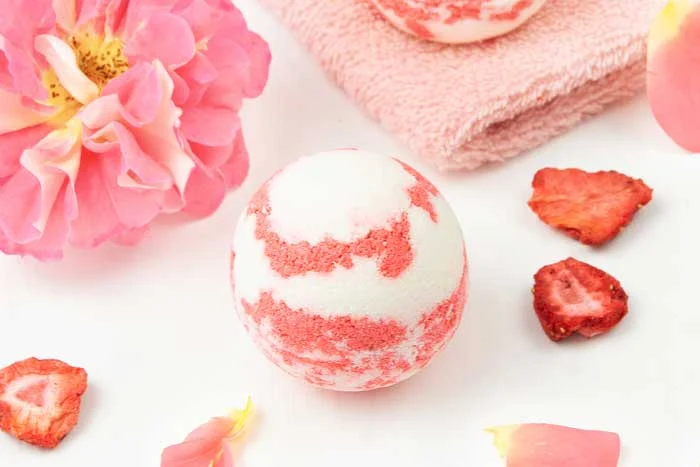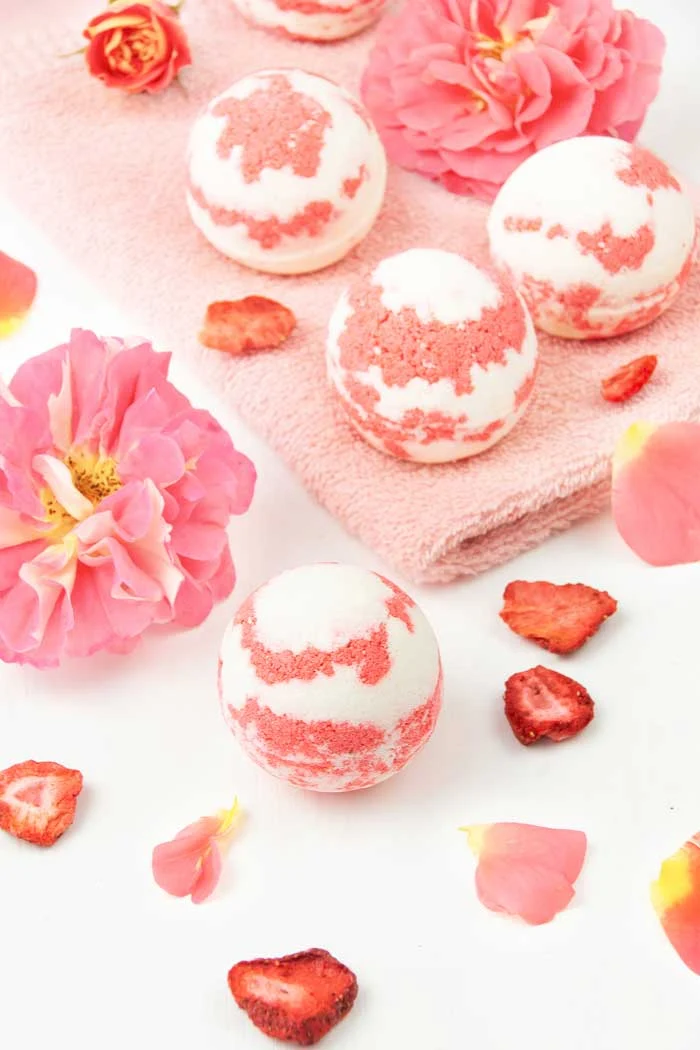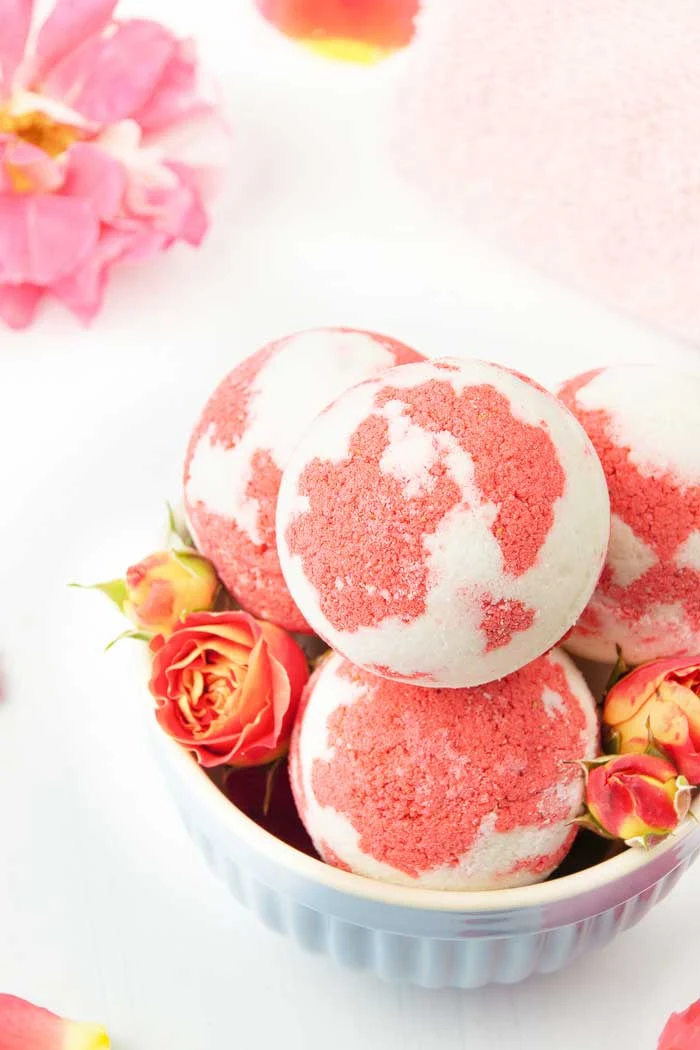These strawberry milkshake bath bombs are courtesy of guest blogger Irena of Country Hill Cottage. Her DIY moisturizing bath bombs recipe is made with nourishing milk powder and a lovely addition to your bath time.
My pretty strawberry milkshake bath bombs make the bath time fun and colourful. These DIY moisturizing bath bombs are formulated with dried milk, strawberry powder, and essential oils. Dropped into warm water, the homemade bath fizzies begin to fizzle and to release hydrating ingredients that make dry skin feel soft and nourished.
Homemade bath bombs are also a thoughtful handmade gift idea for many occasions that will provide the recipient with a spa treatment right at home. They are lovely beauty presents for Mother's Day, Valentine's, birthdays, anniversaries and holiday season. Enjoy!
Irena xx
I recently shared a homemade bath bomb recipe with cocoa butter, and Cari has a recipe for bath bombs with shea butter. While the butters in both recipes have wonderfully moisturizing qualities and are great for moisturizing bath products, I wanted to make DIY moisturizing bath bombs recipe without oils.
The drawback of oils is that they reduce the fizziness and can make the bath bombs fizzle out too fast or not at all. After all, bath bombs are so much fun because they fizzle, smell amazing and colour the bath water.
So my goal with this moisturizing bath products DIY was to create a homemade bath bomb recipe that gives a great fizzing while also softening your skin as you soak in the tub. The ingredient that achieves just that is milk powder.
The bath bombs dry rock solid and are similar to commercial bath bombs but homemade and with natural ingredients.
DIY Moisturizing Bath Bombs Recipe
A Bath Bomb Without Cornstarch
Before talking about the ingredients in these bath bombs, I want to mention that this bath bomb recipe is prepared without cornstarch. If you have wondered about a substitute or replacement for cornstarch in bath bombs, the answer is you don’t need one.
Cornstarch is mostly used a filler in bath bombs to control the fizziness. Skipping it will only result in bath bombs that dissolve faster than bath bombs that have cornstarch as an ingredient.
What materials do I need to make DIY moisturizing bath bombs?
Now let’s have a look at the ingredients you need to make this recipe:
Baking soda and citric acid
Baking soda (sodium bicarbonate) is the main ingredient, and citric acid is needed to activate the soda in these moisturizing bath bombs.
Both materials in conjunction create the lovely fizzing reaction when they come in contact with water. A ratio of 2:1 will give you a great fizz.
Milk powder
The moisturizing bath bombs recipe gets its moisturizing qualities from the addition of powdered milk. The milk fat and proteins make your skin feel soft and nourished. Furthermore, the lactic acid, a mild alpha hydroxy acid, gently exfoliates the skin while you soak.
For a vegan alternative, try using powdered coconut milk. It doesn't have the lactic acid, but it is good for moisturizing bath products.
Besides oils, milk powder is one of my favorite ingredients to make moisturizing bath products.
Strawberry powder
Strawberries are a rich source of vitamin C, which fights free radicals on your skin, and folic acid, which promotes cell regeneration. Strawberries also contain an antioxidant called ellagic acid that is useful to prevent collagen destruction, a major cause of wrinkles.
Strawberry powder is a wonderful addition to this moisturizing bath bombs recipe.
I made my own strawberry powder by blitzing free-dried strawberries in a food processor. I recently used this powder in my homemade strawberry lip scrub, too, and it’s also an ingredient in this clay face mask by Cari. (You can also buy strawberry powder already made.)
Learn how to freeze dry strawberries to make your own strawberry powder. Also have directions to make your own fruit powder recipe and how to store it.
Fragrance and essential oils
The dried strawberry powder provides a gentle strawberry fragrance. Since strawberry essential oil doesn’t exist, you can use a cosmetic-grade strawberry fragrance oil to enhance the scent.
If you prefer to keep the bath bomb recipe all natural, essential oils might be a better option. Lavender, rose geranium, vanilla Oleoresin, grapefruit, or ylang-ylang make wonderful additions for these moisturizing bath bombs.
You can also create an essential oil blend to fragrance your bath bombs. Here are three suggestions that I like:
- skin nourishing: geranium
, lavender, niauli
(1:1:1)
- relaxing: lavender, neroli, and vanilla Oleoresin (2:1:1)
- uplifting: grapefruit, peppermint, and lemon
(1:1:1)
Of course, you can create other blends according to your personal preference or with what you have available. Just keep in mind that essential oils are very potent and to avoid skin irritation don’t exceed the dosage listed in the recipe.
Alcohol
We have to add a liquid to shape the bath bombs. A neutral alcohol with high alcohol content, such as rubbing alcohol, vodka, or Everclear (190-proof), does this job best.
The alcohol also acts as a solbuliser to distribute the fragrance or essential oil(s) in the bath bombs. Looking at the recipe, you can see that before adding the essential oil(s) to the dry ingredients, they are first mixed with the alcohol.
The alcohol evaporates completely while the moisturizing bath bombs dry. I found that bath bombs made with alcohol create a stronger fizz compared to the ones made with oils.
Mica powder (optional)
While strawberry powder gives the mixture a subtle pink hue, I wanted a stronger colour contrast to accentuate the rippled look. Therefore I added a small amount of red mica powder to my mixture to make moisturizing bath bombs.
Polysorbate 80 (optional)
Polysorbate 80 is a solubiser. I added a tiny amount to ensure the mica powder and essential oil actually mix with the bath water instead of just swimming on top. I also found that Polysorbate improved the texture of the bath bombs.
Moulds
I shaped my bath bombs in round metal bath bomb moulds. These metallic moulds come in different sizes and are very sturdy. They are your best option when you plan to form a lot of bath bombs.
Plastic ball ornaments can also be used, but I found that the plastic sometimes breaks when you press the ornament tightly together. Forming bath bombs takes some practice, and I have put together a few tips below to help you get there.
If this is your first time making bath bombs, I recommend using a silicone muffin pan or a silicone mould. Simply press the bath bomb mixture into the pan or mould, let dry for a couple of hours and then gently bend the mould to release the bath bombs. I used this technique to form these mini bath bomb favours.
Troubleshooting homemade bath bombs
High humidity
Moisture is your number one enemy when it comes to making bath bombs. If possible work in an environment with low humidity. Soda draws in moistures from the air, which makes it difficult to shape the bath bombs and prevents them from setting properly.
But don’t worry, your product isn’t ruined because you can repurpose the mixture and use it as a fizzy bath soak. Simply let the mixture dry, then layer it into a mason jar or storage container. When taking a bath, add a 1/3 of a cup to the water and enjoy the same benefits as with the bath bombs.
Using sphere moulds
It may seem counterintuitive, but packing and pressing the bath bomb mixture tightly into each half of the mould makes it difficult to unmould the bath bomb and can cause the product to break in half.
Instead, loosely overfill both parts of the mould with a generous amount of mixture. There should be a high heap in each half. Then press both pieces firmly together and brush away any excess.
Unmoulding bath bombs
You may have heard to let the bath bombs dry in the mould, but I don’t recommend this method for sphere moulds. The alcohol has to evaporate so the bath bomb can harden.
You can unmould them immediately after filling and pressing the mould together. To do this, take off one half of the mould and then the other. In case the mould doesn’t come off right away, gently tap the mould and it should come right off.
Let the bombs dry overnight before packaging.
How to make moisturizing bath bombs recipe
Prep time: 30 min
Yields: 5 - 7 bath bombs
Ingredients
- 2 cups / 260 g / 9.2 oz baking soda (sodium bicarbonate)
- 1 cup / 125 g / 4.4 oz citric acid
- 1 cup / 90 g / 3.2 oz milk powder
- 1/3 cup / 10 g / 0.3 oz strawberry powder
- 1/2 – 2/3 cup / 120 – 150 ml / 4 – 5 fl oz rubbing alcohol, Vodka or Everclear
- up to 10 g / 0.4 oz fragrance or essential oil(s)
- 1 – 2 tsp red mica (optional)
- 1 tsp / 7 g / 0.25 oz Polysorbate 80 (optional)
Tools
- digital scale
or measuring cups and spoons
- sieve
- mixing bowl
- whisk
- spritz bottle
- rubber gloves
- bath bomb moulds
Instructions
Step #1
Sieve the baking soda, citric acid, and milk powder into a large mixing bowl.
Step #2
Whisk in the strawberry powder and red mica powder.
Step #3
Mix the fragrance / essential oil(s), Polysorbate 80, if using any, and 1 tablespoon alcohol. Add to the dry ingredients and knead with your hands until well combined.
Step #4
Spritz the bath bomb mixture with alcohol, a little at a time, and incorporate well before adding more. Don’t add too much liquid at once as the citric acid and baking soda will start to fizz and bubble. Break down any lumps. The bath bomb mixture should have the look and consistency of damp sand and keep its shape when you pressed it in your hands.
Step #5
Loosely fill both halves of a bath bomb mould with the mixture, creating a heap higher than the mould.
Step #6
Press firmly together and wipe away any excess.
Step #7
Carefully unmould the bath bomb and place on a baking tray (sheet) lined with bubble wrap and allow to dry overnight.
How to use bath bombs
Add one or two moisturizing bath bombs in the bottom of your shower or in your warm bathtub to create fizz and bubbles and to release the fragrance.
Shelf life and storage
Store these moisturizing bath bombs in an airtight container, away from heat and moisture as moisture can cause the bombs to lose their fizziness. The bombs can be kept for up to 2 months.
About
Hi, my name is Irena and I blog with my sister Cyna at Country Hill Cottage, where we share beauty and skin care DIYs, craft ideas, recipes, and a ton of pretty printables. I’m a professional florist and aromatherapist in training. I love flowers and everything floral, and I’m very passionate about essential oils, natural skin care and beauty products. You can connect with me on Pinterest, Facebook, and Instagram.

Strawberry Milkshake Bath Bomb
materials:
- 2 cups / 260 g / 9.2 oz baking soda (sodium bicarbonate)
- 1 cup / 125 g / 4.4 oz citric acid
- 1 cup / 90 g / 3.2 oz milk powder
- 1/3 cup / 10 g / 0.3 oz strawberry powder
- 1/2 – 2/3 cup / 120 – 150 ml / 4 – 5 fl oz rubbing alcohol, Vodka or Everclear
- up to 10 g / 0.4 oz fragrance or essential oil(s)
- 1 – 2 tsp red mica (optional)
- 1 tsp / 7 g / 0.25 oz Polysorbate 80 (optional)
tools:
- digital scale or measuring cups and spoons
- sieve
- mixing bowl
- whisk
- spritz bottle
- rubber gloves
- bath bomb moulds
steps:
- Sieve the baking soda, citric acid, and milk powder into a large mixing bowl.
- Whisk in the strawberry powder and red mica powder.
- Mix the fragrance / essential oil(s), Polysorbate 80, if using any, and 1 tablespoon alcohol. Add to the dry ingredients and knead with your hands until well combined.
- Spritz the bath bomb mixture with alcohol, a little at a time, and incorporate well before adding more. Don’t add too much liquid at once as the citric acid and baking soda will start to fizz and bubble. Break down any lumps. The bath bomb mixture should have the look and consistency of damp sand and keep its shape when you pressed it in your hands.
- Loosely fill both halves of a bath bomb mould with the mixture, creating a heap higher than the mould.
- Press firmly together and wipe away any excess.
- Carefully unmould the bath bomb and place on a baking tray (sheet) lined with bubble wrap and allow to dry overnight.
NOTES:
Store the bath bombs in an airtight container, away from heat and moisture as moisture can cause the bombs to lose their fizziness. The bombs can be kept for up to 2 months.













